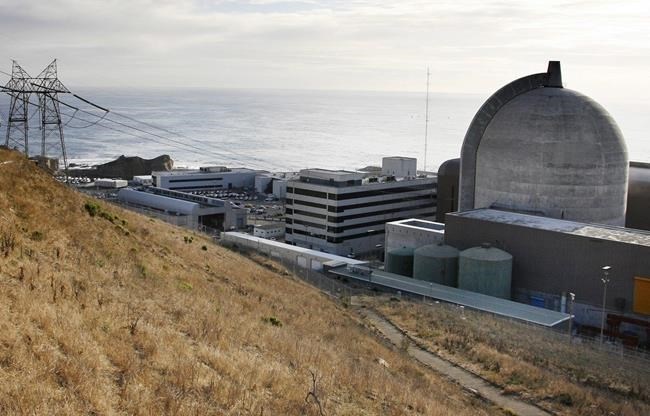
FILE - This Nov. 3, 2008, file photo, shows one of Pacific Gas and Electric's Diablo Canyon Power Plant's nuclear reactors in Avila Beach , Calif. Pacific Gas & Electric Co. and environmental groups said Tuesday, June 21, 2016, that they've reached an agreement that will close the Diablo Canyon plant, California's last nuclear power plant, by 2025. The accord would resolve disputes about the plant that helped fuel the anti-nuclear movement nationally.
Image Credit: AP Photo/Michael A. Mariant, File
June 21, 2016 - 8:10 PM
The rooftop panels and churning turbines of booming solar and wind energy are helping make U.S. nuclear power plants, with all the safety fears and rising costs they bring, obsolete, some experts say. So much so that California's largest utility and environmental groups struck a deal Tuesday to shutter the last facility in the state.
The move marks the end of California's era of nuclear-power plants and comes as the operators of the country's aging nuclear facilities confront rising repair bills at a time when sources of clean, safer energy cost less.
Competition from a glut of natural gas and surging solar and wind production also has dampened enthusiasm in Europe for nuclear power. So did the 2011 disaster in Fukushima, Japan, when an earthquake and tsunami led to meltdowns and radioactive releases at a nuclear plant.
But China is among the countries still building nuclear power plants, and a U.S. industry group says nuclear remains a vital power source despite California's deal.
The 31-year-old Diablo Canyon plant between Los Angeles and San Francisco will shut down by 2025, decades after its location near seismic faults on ocean bluffs helped spark the environmental movement against nuclear power. Pacific Gas & Electric Co. announced plans for the facility in the 1960s.
Conservationists said the success of the Diablo Canyon deal could show the way forward for the country's 60 other commercially operating nuclear plants, most of them more than 30 years old. They said it demonstrates the choice was not between nuclear power and climate-changing fossil fuels.
"For years, we heard you can't fight climate change without nuclear power. That's wrong, of course," said Rhea Suh, president of the Natural Resources Defence Council, one of the environmental groups that negotiated the accord with PG&E. "We're clearly on our way."
The agreement will mean the end of nuclear power generated within the nation's most populous state, an energy source once called essential to meeting its growing needs. However, Southern California still receives some of its electricity from a nuclear plant across the border in Arizona.
With more efficient energy use and an emphasis on renewable energy in California, "there's just not going to be enough need to have to run your nuclear plant," PG&E President Tony Earley told reporters Tuesday.
The utility will save more money closing Diablo Canyon than running it through 2044 as planned, Earley said. The plant supplies 9 per cent of the state's power.
Environmentalists have pressed the Nuclear Regulatory Commission to close Diablo given its proximity to seismic faults in the earthquake-prone state. One fault runs 650 yards from the plant's twin reactors.
PG&E has long said the plant is safe from the largest potential earthquake in the region. But new research has led to more questions about nearby faults, their shaking potential and how the company evaluates them.
"The terrific news is that risk will cease in 2025," said Daniel Hirsch, director of the Program on Environmental and Nuclear Policy at the University of California, Santa Cruz. "The troubling news is that the risk will continue until 2025."
The agreement still requires approval from state agencies. Earley and the environmental groups said neither the state nor federal governments were involved. Gov. Jerry Brown declined to comment immediately.
A national nuclear-power industry group said the circumstances that produced Tuesday's deal are unique to California, where Brown has pushed to move away from fossil fuels, with their climate-changing emissions.
For the rest of the country, "nuclear energy is a vital part of a balanced energy portfolio," the Nuclear Energy Institute said in a statement.
Plans to build new nuclear facilities in the U.S. South have faced costly delays, while proposals for others elsewhere in the country have been scratched.
Southern California Edison's San Onofre nuclear plant, between San Diego and Los Angeles, shut down in 2013 after a $670 million equipment swap failed. The same year, Duke Energy announced it would close the Crystal River Nuclear Plant in Florida after a botched repair job left it facing potentially billions of dollars in additional work.
California already has banned construction of new facilities until the federal government finds a permanent disposal site for radioactive waste.
News from © The Canadian Press, 2016